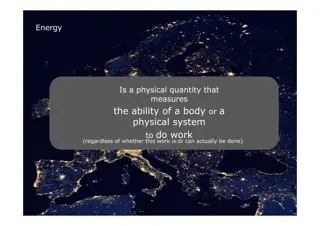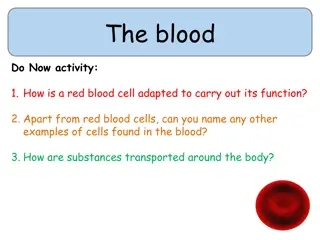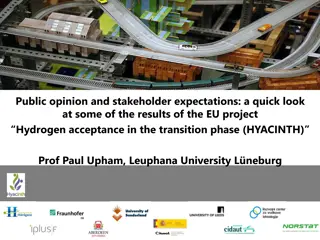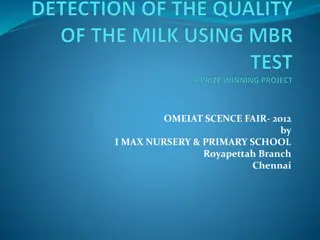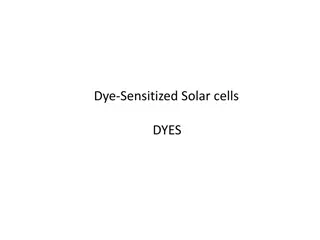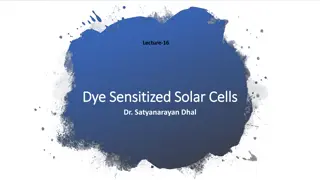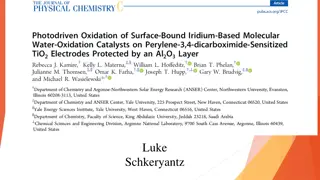Investigation of Avocado, Red Kolanut, and Water Hyacinth Leaves for Dye Sensitized Solar Cells
This study explores the potential of using natural plant dyes from avocado leaf, red kolanut leaf, and water hyacinth leaf in fabricating dye sensitized solar cells (DSSCs). The introduction discusses the need for alternative energy sources due to global warming, with DSSCs offering a low-cost and environmentally friendly solution. The process of how DSSCs work is detailed, emphasizing the role of dyes in converting light into electricity. The research aims to contribute to the development of sustainable energy technologies.
Download Presentation

Please find below an Image/Link to download the presentation.
The content on the website is provided AS IS for your information and personal use only. It may not be sold, licensed, or shared on other websites without obtaining consent from the author.If you encounter any issues during the download, it is possible that the publisher has removed the file from their server.
You are allowed to download the files provided on this website for personal or commercial use, subject to the condition that they are used lawfully. All files are the property of their respective owners.
The content on the website is provided AS IS for your information and personal use only. It may not be sold, licensed, or shared on other websites without obtaining consent from the author.
E N D
Presentation Transcript
INVESTIGATION OF THE SUITABILITY OF AVOCADO LEAF, RED KOLANUT LEAF AND WATER HYACINTH LEAF IN THE FABRICATION OF DYE SEN SITIZED SOLAR CELLS BY OKAFOR PAUL, ADENIKE BOYO,OLADEPO AYINDE AND AKINGBADE FATAI
INTRODUCTION With the continued use of fossil fuels, global warming has become a major concern in today s society. There is therefore need for alternative energy sources. A promising new alternative for solar energy is the dye sensitized solar cell.
INTRODUCTION CONTD DSSc produce a current using natural plant dye pigment and there is therefore no toxic waste material. Dye sensitized solar cells (DSSc) have potential to develop low cost alternative energy to traditional photovoltaic device [1,2] .
INTRODUCTION CONTD. The electrolyte used in these cells are usually composed of an I /I redox couple in organic sovents
INTRODUCTION CONTD. The regenarable redox couple are usually dissolved in organic solvents which results in high conversion efficiencies
INTRODUCTION CONTD (HOW DOES A DSSC WORK)
INTRODUCTION CONTD (HOW DOES A DSSC WORK?) 1 The dye is the photoactive material of DSSC, and can produce electricity once it is sensitized by light. 2 The dye catches photons of incoming light(sunlight and ambient artificial light) and uses their energy to excite electrons
(HOW DOES A DSSC WORK?) behaving like chlorophyll in photosynthesis. 3 The dye injects this excited electrons into The titanium dioxde ( a white pigment commonly found in white paint). 4 The electron is conducted away by nanocrystalline titanium dioxde.
(HOW DOES A DSSC WORK?) 5 A chemical electrolyte in the cell then closes the circuit so that the electrons are returned back to the dye. 6 It is the movement of these electrons that creates energy which can be harvested into a rechargeable battery, super capacitor
SOURCE OF DATA The source of the data is from dye sensitized solar cells fabricated in the physics laboratory, department of physics, lagos state university, and from spectrophotometer readings, taken in the laboratory
METHODOLOGY Avocado leaf, red kolanut leaf and water hyacinth leaves were gathered from a farm in agbara Ogun state. 250g of each plant material was then soaked in 500ml methanol for 24hrs. The cold extraction method was used.
AVOCADO LEAF (Plate 1) AVOCADO AVOCADO LEAF (Plate 1)
METHODOLOGY CONTD. The plant extracts were then filtered and stored in a reagent bottle. Spectrophotometer readings were carried out for each dye. The cells were assembled using TiO thin films on FTO coated glass.
METHODOLOGY CONTD After assembly, readings of current and voltage were taken while the cells were exposed to sunlight.
SPECTROPHOTOMETER ANALYSIS FOR KOLANUT LEAF.
CALCULATIONS Calculations Efficiency of cell with kolanut leaf extract The efficiency of the cell is given by = ( FF x Isc x Voc) /Pin where FF is the fill factor. Isc is the short circuit current. Voc is the open circuit voltage. Pin is the incident solar radiation in watts per meter squared. But FF = (Imax x Vmax)/ (Isc x Voc), where Imax is maximum cell current, Vmax is the maximum cell voltage. Imax is the maximum current obtained at the knee of the I-V curve. Vmax is the maximum voltage obtained at the knee of the I-V curve. Imax for this cell is 580 A= 580 x 10 A. Vmax = 80millivolts = 80 x 10 V. (Note active area of cell =2cm by2cm = 4cm = 4 x 10 m Isc = 600 A = 600 x 10 A Voc = 100 millivolts = 100 x 10 volts, then FF = (580 x 10 x 80 x 10 )/(600 x 10 x 100 x 10 ) = 0.7733. Cell efficiency = Maximum power output per unit area Maximum input power per unit area. Maximum power output = Imax x Vmax = 580 x 10 x 80 x10 = 4.64 x 10 watts. Maximum power output per unit area = (4.64 x 10 )/(4 x 10 )watts per metre squared. = 11.6 x 10 W/m . Solar intensity at time of experiment = 57.5W/m . So efficiency of cell = (11.6 x 10 /57.5) x 100 = 0.2%
CALCULATIONS Efficiency of cell with water hyacinth extract For this cell, Imax = 400 A. Vmax = 90 millivolts, Isc = 900 A. Voc = 120millivolts (See current - voltage graph). Then FF = (400 x 10 x 90 10 )/(900 x 10 x120 x10 ) =0.33. Cell efficiency = ( maximum power output per unit area)/(input power per unit area). Maximum power output per unit area = (36 x 10 )/(4x 10 ) watts per meter squared. = 9x 10 W/m (Note active area of cell =2cmx2cm = 4cm = 4 x 10 m ). Efficiency = (9 x 10 )/(57.5) x 100 = 0.156%.
CALCULATIONS CONTD Efficiency of cell with Avocado leaf extract For this cell, Imax = 470 A, Vmax = 38millivolts, Isc = 480 A, Voc = 43millivolts, then FF = (470x 10 x38 x10 )/(480 x 10 x43 x10 ) =0.865. Efficiency = (maximum power output per unit area)/(input power per unit area). Maximum power output = Vmax x Imax = 38 x 10 x 470 x 10 =1.786 x 10 W. Maximum power output per unit area = (1.786 x 10 )/(4x 10 ) = 0.044W/m , then efficiency = (0.044)/(57.5) x 100 = 0.07%. Location of experiment, ie where readings were taken was Lagos State University, Ojo, Lagos on the 27th of july 2016 at 5:15 p.m.
CONCLUSION Kolanut leaf has the highest efficiency of 0.2%. This is followed by water hyacinth with efficiency of 0.156%. Avocado leaf has efficiency of 0.07%. Generally, the efficiency of these cells can be enhanced by using polymeric gel electrolytes.
CONCLUSION CONTD. e.g. polyvinyl acetate and some organic acids, like benzoic acid, cholic acid. This promotes long term stability of the cells and makes the dye sensitized solar cell a reliable alternative source of energy to fossil fuels.
Thank you Thanks for listening
REFERENCES References [1] M.K. Nezeerudin P. Pechy, T. Renound Engineering of efficient panchromatic sensitizersfor new crystalline TiO based solar cells. Am Chem Soc 123(2001) 1613-1624 [2] M. K. Nezeerudin, A. Kay I. Rodico, M Gratzel. Conversion of light to electricity by cis-X bis (2,2 bypyridil-4,4 dicarboxylate ruthenium (11). Charge transfer sensitizers. AmChem Soc 115 (1993)63826390 [3] A.F. Noguira, J R Durrant M - A. D Paoli, Dye sensitized nanocrystalline solar cellsemploying a polymer electrolyte Adv. Mater 13(2004) 1455- 1468 [4] A.F. Noguira, C. longo. M.A Paoli, Polymers in dye sensitized solar cells overview andperspectives, Coord chem.. Rev 248(2004) 145555- 1468 [5] K. Murakoshi R. Kogure, Y Wada. S Yanagida, Fabrication of solid state dye SensitizedTiO solar cells combined with polypyrrole, sol Energy Mater solar cells 55 (1998) 13-125
REFERENCES CONTD [6]K. Tennakone, G.R.R.A. Kumara. A solid state photovoltaic cells sensitized with aruthenium bypyridil complex. J phys D. APPS phys 31(1998) 1492 -1496 [7] E Chatzraslogue. T Sergio populous. A.G. Kentos. The influence of metal carbon andthe filter on the performance of dye Sensitized solar cells using polymer gel redox electrolytes. J Photochem. Photobiol A chem. 192(2007)49- 55 [8] L. Tennakone G.K.R. Senadecca. A quassi solid state dye sensitized solar cells basedon a sol gel nanocomposite electrolyte containing ionic liquid chem mater 15(2003)1825-1829 [9] L. Wang,S.B. Fang. A 7.72% efficient dye sensitized solar cell based on nvel- heckale-like polymer gel electrolyte containing latent chemically cross linked gel electrolytepercussors. Chem. Commum. (2005) 5687-5689 [10] M. L., S feng X. Xian x L, X Zhon Y. Lin. The use of poly(vinylpyridine) co anglonitrilein polymer electrolysis for quassi solid dye sensitized solar cells based on compositepolymer electrolytes containing fumed silica nanoparticles. Chem commum 14(2004) 1662-1663
REFRENCES CONTD. [11] H Kim Ms Kang Y J Kim. Dye sensitized nanocrystalline solar cells based oncomposite polymer electrolyte containing fumed silica nanoparticles. Chem commum 14(2004) 1662-1663 [12] U Bach, D Lupo P conte. Solid state dye sensitized mesoporous TiO solar cells withhigh photon to electron conversion efficiencies. Nature 395(1998) 583-585 [13] D Gebeyehu C.J. Brabee N.S. Sacrifti. Solid state organic/inorganic hybrid solar cellsbased on conjugate polymers and dye sensitized TiO electrodes. Thin solid films 403(2002) 271-274 [14] H.X. Wang H.U. B.F. Xue Z.X. Wang, Q.B. Meng. Solid state composite electrolyteL.I./3 pydroxypropinitrile/SiO for Dye Sensitized solar cells . J. Am. Chem Soc 127(2005) 6394-6401 [15] M. Matsumoto. H. Miyazaki. A dye sensitized photoelectrochemical cell constructedwith polymer solid electrolyte solid state ions 89(1996)263-267
REFERENCES CONTD [16] I. B. Oregan and M Gratzel, Nature, 353(1991) 737 [17] D. Wei and G. Amaratuga. Int. J. Electrochem Sci, 2(2007)897 [18] M.H. Lai M.W. Lee. G.J. Wang and M.F. Tai, Int J. Electrochemical science 6(2001)2122 [19] A Yella, H.w. Lee H.N. Tsao C.Y. Yeh S.M. . Zakeeeruddan and M. Gratzel, science 334(2004)127 [20] E. Figgermeir and A Hagfeldth Int J photoenergy 6(2004)127 [21] M. I. Asghar K Miettunen J. Halma. P. Vahermaa. M Toila. K. Aitola and P Lund. Energy Environmental sci 3(2010)418 [22] M. Gratzel Cr Chim, 9(2006)518 [23] M. Toivola. J. Halme P Lund Int J of photoenergy, DOI, 10, 1155/2009/786429 [24] A Hinsch J.M. Kroom R Keru I Ulendorf, J Ferber, Prog in photovoltaics 9(2001)425 [25]S.Y. Dai. J. Wang Y.F. Sui, S.H. Chen S.F. Xiao Y Huan Inorg F.T. Kong and K J Wang Inorganic Chim. Acta 36(2008)786




